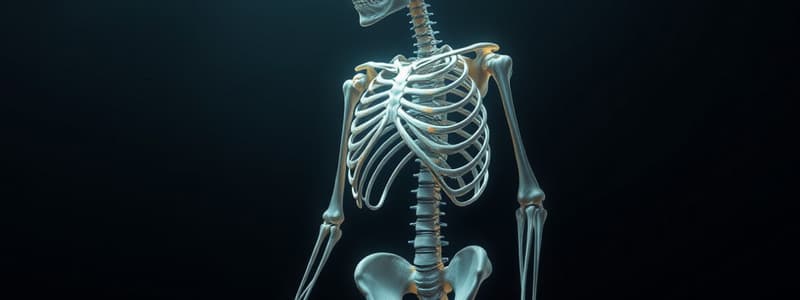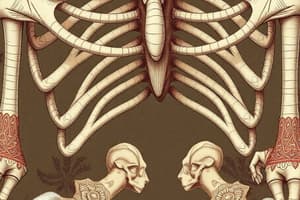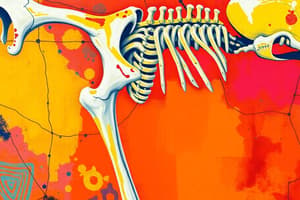Podcast
Questions and Answers
What are the hardest structures in the skeletal system composed of?
What are the hardest structures in the skeletal system composed of?
Bones
What reduces friction and serves as a model for bone formation?
What reduces friction and serves as a model for bone formation?
Cartilage
What attaches bone to muscle?
What attaches bone to muscle?
Tendons
What connects bone to bone?
What connects bone to bone?
What determines the hardness of the components in the skeletal system?
What determines the hardness of the components in the skeletal system?
Bones are primarily composed of ______ and minerals.
Bones are primarily composed of ______ and minerals.
Which of the following is NOT a classification of bones based on shape?
Which of the following is NOT a classification of bones based on shape?
What part of a long bone is the shaft called?
What part of a long bone is the shaft called?
What is found at the ends of long bones?
What is found at the ends of long bones?
Articular cartilage thins in older people, leading to arthritis.
Articular cartilage thins in older people, leading to arthritis.
What type of bone cell maintains the bone matrix?
What type of bone cell maintains the bone matrix?
Which type of ossification occurs within connective tissue membranes?
Which type of ossification occurs within connective tissue membranes?
What process allows for the formation of new bone?
What process allows for the formation of new bone?
What is the primary function of osteoblasts?
What is the primary function of osteoblasts?
Flashcards are hidden until you start studying
Study Notes
Composition of the Skeletal System
- Bone is the hardest structure, made primarily of minerals, providing support and strength.
- Cartilage minimizes friction and serves as a template for bone development.
- Tendons connect muscles to bones, facilitating movement.
- Ligaments link bones together, ensuring joint stability.
- Connective tissues comprise the skeletal system, differing in collagen and elastin content, influencing hardness.
- Extracellular matrix includes collagen, ground substance, organic molecules, water, and minerals.
Collagen and Proteoglycans
- Collagen provides flexibility in bones and skin.
- Proteoglycans are large polysaccharides attached to proteins, crucial for water storage.
Bone Classification
- Long bones include femur, tibia, and fibula.
- Short bones encompass carpals, tarsals, and phalanges.
- Flat bones consist of ribs, sternum, and skull.
- Irregular bones make up vertebrae and facial bones.
Structure of Long Bones
- Diaphysis is the shaft, composed of compact bone.
- Epiphysis contains spongy bone, with articular cartilage on the ends to reduce friction.
- Epiphyseal plate allows for growth during puberty, becoming the epiphyseal line as growth ceases.
- Medullary cavity holds red (blood) or yellow (adipose) marrow.
- Periosteum is the membrane covering the bone surface; endosteum lines the medullary cavity.
Bone Cells
- Osteocytes maintain the bone matrix, which includes collagen and minerals.
- Osteoblasts are responsible for building bone and creating bone matrix.
- Osteoclasts break down bone tissue.
Bone Histology
- Lacunae are small spaces where osteocytes reside within lamellae.
- Canaliculi are tiny channels for nutrient transport and waste removal.
- Central canal contains blood vessels, crucial for supplying materials like calcium.
- Osteons are the structural units of compact bone.
Types of Bone Tissue
- Compact bone (cortical): dense, forms the outer layer of bones and has a higher matrix content.
- Spongy bone (cancellous): found in epiphyses and the center of bones; lighter for improved mobility, containing trabeculae with marrow.
Bone Physiology
- Ossification is the process of bone formation.
- Osteoblasts initiate bone development and transform into osteocytes once encased in bone matrix.
- Ossification centers are where bone formation begins; primary centers form diaphyses while secondary centers form epiphyses.
Types of Ossification
- Intramembranous ossification occurs within connective tissue membranes, primarily for flat bones like those of the skull.
- Endochondral ossification replaces cartilage with bone, forming a cartilaginous model that is later transformed into bone tissue.
Studying That Suits You
Use AI to generate personalized quizzes and flashcards to suit your learning preferences.




